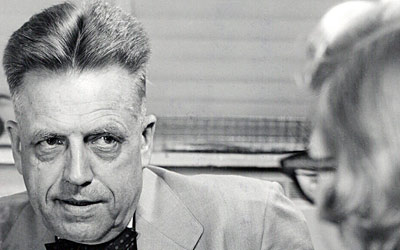Zoologist Kinsey embarked on the research for which he became known while teaching a "marriage course" at Indiana University.
By the 1930s, so-called “marriage courses” became increasingly popular on college campuses across the United States. At most schools, these courses emphasized traditional religious and moral teachings about marriage and family, and offered only basic, often rather abstract, information about the human body and human sexuality. In 1938, due to student demand, Indiana University began offering a course of its own, led by zoology professor Alfred Kinsey.
Kinsey would go on to become famous—and infamous—for his scientific studies of male and female sexuality, but in the 1930s he was still engaged in his extremely detailed study of the gall wasp, in search of a “comprehensive theory of evolution”. Kinsey approached the marriage course from a scientific point of view, tapping additional faculty from the biology, zoology, psychology, sociology, and law departments to cover every aspect of his topic. Kinsey required that his students be married, engaged, or have senior class standing. Each prospective student was also required to meet with Kinsey, who would approve or deny admission. Ultimately, the roster for the first IU marriage course contained 98 students – 28 men and 70 women.
By the second lecture, it was clear to students and administrators that Kinsey would not tolerate the vague moralizings found at other colleges: his lecture titled “Reproductive Anatomy and Physiology” offered, among other things, diagrams of male and female anatomy, and a detailed discussion of the available varieties of birth control.
The course became an extremely popular part of the curriculum, despite objections from some local religious leaders and from members of the IU faculty, including some of the lecturers in the original marriage course, who dropped out as Kinsey became more focused on the particularities of human sexuality. Kinsey was beginning to take personal histories from his students and was asking for their frank comments at the end of every semester. This process began to steer the zoologist away from his study of insects and toward what would become his life’s work.
Faced with an ultimatum from university administrators, Kinsey resigned as lead instructor of the marriage course in 1940. His students had gained straightforward knowledge of human biology which they could not find elsewhere; Kinsey had gained a valuable new research tool – the detailed, private, personal interview. The technique would become central to his research. For three years during the late 1930s, Alfred Kinsey and his marriage course students fostered a relationship that was mutually beneficial and that has not been given due credit for its impact on the Kinsey whom history remembers.
Source: Donna J. Drucker, “‘A Noble Experiment’: The Marriage Course at Indiana University, 1938-1940,” IMH September 2007
A Moment of Indiana History is a production of WFIU Public Radio in partnership with the Indiana Public Broadcasting Stations. Research support comes from Indiana Magazine of History published by the Indiana University Department of History.






















